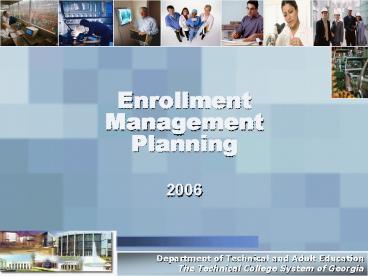Enrollment Management Planning - PowerPoint PPT Presentation
1 / 20
Title:
Enrollment Management Planning
Description:
Identify possible internal/system reasons for enrollment decline ... and placement exam regulations stifle flexibility in admissions and ... – PowerPoint PPT presentation
Number of Views:74
Avg rating:3.0/5.0
Title: Enrollment Management Planning
1
Enrollment ManagementPlanning
- 2006
Department of Technical and Adult Education The
Technical College System of Georgia
2
Enrollment Management Planning Committee
DTAE
- Charge to the Committee
- Identify possible internal/system reasons for
enrollment decline - Review policies and identify real and perceived
barriers to enrollment growth - Identify policy and practices that can influence
enrollment growth
3
Discussion
DTAE
- External factors impact student enrollment
- Complex, multi-faceted
- Competition from proprietary schools
- Escalating costs
- Focus should be on systemic and internal factors
on which DTAE can have an impact policy,
procedures, strategies, practices - Enrollment Management must encompass planning,
recruiting, and retention
4
Methodology
DTAE
- 2006 DTAE Enrollment Management Decline Study
- Focus groups of students, staff/administrators
from 9 colleges chosen for diversity - Information from survey of college presidents
5
Findings and Recommendations
DTAE
- HOPE cap. Detriment to seamlessness and
retraining. Impacts dual enrollment. - Recommendation Advocate for the removal of the
HOPE cap, particularly for high school students.
6
Findings and Recommendations
DTAE
- Relevancy of Programs and Services. Flexibility,
responsiveness, adaptation, and speed are
critical to todays student. - Recommendations
- Revise Probe and IFCC procedures
- Strengthen distance education programs and
support services - Change processes to emphasize student-centered
practices
7
Findings and Recommendations
DTAE
- Funding Constraints. Funding declines directly
impact enrollment faculty, recruitment,
competitiveness, and currency of offerings - Recommendations
- External - Advocate strongly for funding formulas
that provide parity with BOR two-year
institutions. - Internal - Revise fee structure for high cost
programs.
8
Findings and Recommendations
DTAE
- Technology Fee. Cost prohibitive and perceived
negatively by students - Recommendation Advocate for HOPE legislation
revision to pay technology fee
9
Findings and Recommendations
DTAE
- Image and Brand. Statewide campaign is needed
funding constraints at local level inhibit
marketing efforts - Recommendations
- Initiate a statewide marketing campaign
- Advertise more aggressively and in broader venues
10
Findings and Recommendations
DTAE
- Seamlessness between DTAE and BOR Institutions.
Transfer issues are both critical and confusing
to students. Transferability has strategic value
for DTAE colleges. - Recommendation Expand current transfer
agreements with BOR colleges where applicable. - Orientation/catalogue should clarify issue
11
Findings and Recommendations
DTAE
- Wait Lists. List currently exceeds 10,000. HOPE
cap deters students from continuing education
while waiting for program entry. - Recommendation Revise tuition structure for
high-cost programs to support additional classes
that will reduce wait times.
12
Findings and Recommendations
DTAE
- Retention. Retention is a statewide issue 50
rate from 2005-2006. Retention and recruitment
services have suffered under budget cuts. - Recommendations
- Conduct further study on underlying reasons
- Provide training on retention and recruitment to
all staff - Recognize the role and impact of funding as a key
factor and identify ways to restore funding
13
Findings and Recommendations
DTAE
- Customer Service. Efficient and student-focused
admissions procedures are critically important to
students. Flexibility and innovation in class
scheduling and students services are impeded by
funding declines. - Recommendation Identify best practices for
possible state models. Review all processes for
efficiency and student focus.
14
Findings and Recommendations
DTAE
- Enrollment Management. The issue encompasses a
dynamic integration of multiple factors related
to recruitment and retention. System-wide focus
and systemic practices will influence enrollment. - Recommendations
- State-wide training from leaders in the field.
- Establish best practices with strong
recommendations for implementation at local
level. - Provide state-level leadership position to guide
efforts.
15
Findings and Recommendations
DTAE
- Special Support for Rural Schools. Unique
characteristics apply to northern and southern
rural colleges that impact enrollment and
retention. - Recommendation Establish a committee to identify
strategies for rural areas that will influence
enrollment.
16
Findings and Recommendations
DTAE
- Rules and Procedures. Program review and
curriculum modifications need a rapid response
process to be competitive. The IFCC process
should be reviewed to insure competitiveness at
the local college level - Recommendation Establish a committee to drill
down into rules and procedures and identify those
that inhibit clarity, flexibility, and
responsiveness - Recommend options
17
Policies to Review
DTAE
- Assessment V.B.2.
- Rationale.TCCs offer short-term programs of
study. Admissions and placement exam regulations
stifle flexibility in admissions and
responsiveness to training needs. - Recommendations. Clarify placement testing
requirements for TCCs. Allow waiving of placement
testing requirements for TCCs over 25 credit
hours.
18
Policies to Review
DTAE
- Articulation and Transfer IV.J.
- Rationale Transfer and advance credit issues are
critical to students seamlessness and
transferability between DTAE and BOR are hindered
by testing regulations seamlessness is hindered
by out-of-date mini-core agreements. - Recommendations
- Clarify and standardize DTAE transfer and
articulation credit policy standardize
procedures to guide local colleges. - Expand mini-core agreements for SACS accredited
schools.
19
Findings and Recommendations
DTAE
- Overall, impediments to enrollment management are
not policy driven. - Recommendations
- Identify the procedures most critical to
enrollment management and review for efficiency,
responsiveness, flexibility, and student-centered
focus. - Disseminate revised procedures statewide provide
support at every level of execution.
20
Conclusion
DTAE
- No single solution will correct enrollment
decline - Although policies need to be closely reviewed
(other than the 2 identified), it is when they
are operationalized at the campus level (and
become procedures) that the student-focus seems
often to be weak - Multiple and state wide approaches working in
dynamic interaction are needed to reverse the
decline. - System-level support and leadership are critical.
- Effects of decreased funding and budget
reductions have had a negative impact on
recruitment, enrollment and retention.

